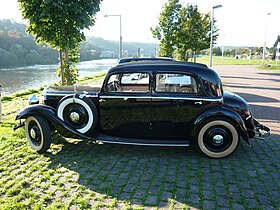Mercedes-Benz W21
| Mercedes-Benz W 21 | |
|---|---|

Mercedes-Benz 200 W21 4-door long version “Limousine” (1935)
|
|
| Overview | |
| Manufacturer | Mercedes-Benz |
| Also called | Mercedes-Benz Typ(e) 200 |
| Production | 1933–1936 15,622 units |
| Assembly | Stuttgart, Germany |
| Body and chassis | |
| Class | Mid-size luxury car |
| Body style | Standard length: 4-door ”Limousine” (sedan) 4-door ”Limousine” (sedan) (from 1935) Torpedo bodied 2-door “Tourenwagen” Cabriolet Sport-Roadster Long wheelbase (from 1934: 4-door ”Pullman-Limousine” 6-seat “Landaulet” (cabriolet-style folding roof for third row passengers only) Torpedo bodied 6-seat “Tourenwagen” 4-door long ”Limousine” (sedan) Cabriolets (long bodied - a choice of several types) |
| Layout | FR layout |
| Powertrain | |
| Engine | 1,961 cc I6 |
| Dimensions | |
| Wheelbase | 2,700 mm (110 in) or 3,050 mm (120 in) |
| Length | 4,060 mm (160 in) - 4,550 mm (179 in) |
| Width | 1,630 mm (64 in) |
| Height | 1,580 mm (62 in) |
| Chronology | |
| Predecessor | |
The Mercedes-Benz W 21 was a six-cylinder passenger car launched in 1933 using the name Mercedes-Benz Typ 200. It was one of several Mercedes-Benz models known, in its own time, as the Mercedes-Benz 200 (or sometimes, in this case, as the Mercedes-Benz Typ(e) 200) and is therefore in retrospect more commonly referred to using its Mercedes-Benz works number, “W21”.
The car was a development upmarket from the manufacturer’s W15, itself introduced two years earlier. The W21 replaced the (in its own day known as the Mercedes-Benz Typ(e) 200 “Stuttgart”) which the company had been manufacturing since 1928.
The car was available as a two- or four-door Torpedo bodied “Tourenwagen”, a four- and (from 1935) two-door “Limousine” (sedan/saloon), a three- or four-seater Cabriolets or as a sporting two-seater.
In 1934 a lengthened version of the car was introduced, its wheel base increased by 350 mm (14 in) to 3,050 mm (120 in). Models offered on the longer wheelbase included a six-seater “Pullman-Limousine”, a “Pullman-Laundaulet”, a longer Torpedo bodied “Tourenwagen”, a more streamlined 4-door “Limousine” (sedan/saloon) and three different longer wheel base Cabriolets listed respectively as the “Cabriolet A”, the “Cabriolet B” and the “Cabriolet D”.
The side-valve six-cylinder engine had a capacity of 1,961 cc which produced a claimed maximum output of 40 PS (29 kW; 39 hp) at 3,200 rpm. The engine shared its 85 mm (3.3 in) piston stroke length with the smaller 6-cylinder unit fitted in the manufacturer’s W15 model, but for the W21 the bore was increased by 5 mm (0.20 in) to 70 mm (2.8 in). The stated top speed was 98 km/h (61 mph) for the standard length and 95 km/h (59 mph) for the long bodied cars. Power passed to the rear wheels through a four-speed manual transmission in which the top gear was effectively an overdrive ratio. The top two ratios featured synchromesh. The brakes operated on all four wheels via a hydraulic linkage.
During the model’s final year, Mercedes-Benz announced, in June 1936, the option of a more powerful 2,229 cc 55 PS (40 kW; 54 hp) engine, which was seen as a necessary response to criticism of the car’s leisurely performance in long bodied form.
In terms of features and performance the W21 represented considerable progress when compared to the , and was priced at the same level although it was equipped a little more simply and in standard-wheelbase form was a little smaller. The appearance of a long-wheelbase version a year after the introduction of the standard bodied car was in part intended to address comments that the W21 as originally launched was a little small to be considered a full-size taxi. Nevertheless, the standard-wheelbase model achieved output of 9,281 cars during a production run of slightly more than three years, while the long-wheelbase model achieved 6,341 cars during a shorter production run of slightly above two years.
...
Wikipedia
